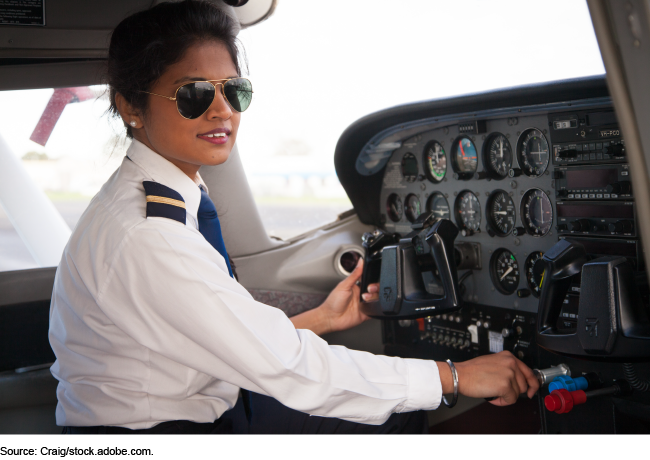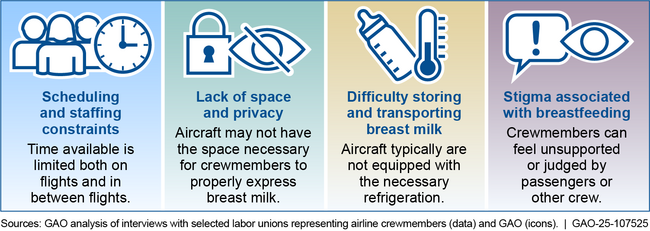Women in Aviation: Options Available to Lactating Crewmembers and Barriers to Expressing Breast Milk on the Job
Fast Facts
Leading health organizations recommend women breastfeed for at least 12 months. Yet lactating flight attendants and pilots may not have enough time or private space to pump while on duty.
Some airlines let crewmembers use wearable breast pumps while in flight. We looked at how the Federal Aviation Administration has advised airlines to assess potential safety risks of pumps.
Other options may include using airport lactation rooms between flights. But FAA can't require airlines to have these accommodations.
While these options are helpful, we found that they may not fully accommodate the needs of lactating crewmembers.

Highlights
What GAO Found
Pilots and flight attendants (crewmembers) who are lactating may work long shifts and, as a result, may need to express breast milk while on duty. In 2024, 10 percent of U.S. commercial pilots, and 79 percent of U.S. commercial flight attendants, were female. In accordance with Federal Aviation Administration (FAA) regulations, pilots at large U.S.-based airlines may be scheduled for flight time of up to 8 hours between rest periods, while flight attendants may be on duty for as long as 14 hours. Representatives of selected airlines identified the use of wearable, battery-operated breast pumps as one option available to lactating crewmembers while in flight. Other options available to lactating crewmembers include pumping in airport lactation facilities between flights and taking extended leave to delay the return to work after childbirth, according to the representatives.
According to labor unions representing airline crewmembers, crewmembers may face several barriers to expressing breast milk upon returning to work. For example, crewmembers are only allowed to pump during noncritical phases of flight or between flights, neither of which may provide sufficient time to do so.
Barriers to Expressing Breast Milk That Airline Crewmembers May Face

FAA and selected airlines have leveraged existing processes to address safety implications of crewmembers' use of breast pumps on aircraft. In January 2025, FAA issued an informational document to airlines that identifies FAA regulations, procedures, and guidance applicable to crewmembers' onboard pumping, including how airlines can determine the safety of wearable breast pumps. This document advises airlines to consider and assess potential safety risks, such as effects on crewmembers' ability to carry out their safety duties, and whether pumps that use wireless technology could interfere with aircraft navigation and communications systems. GAO found that three of the eight largest airlines have used existing risk management processes to assess safety risks associated with crewmembers' use of breast pumps and establish policies to address identified risks. These airlines require, for example, that breast pumps be wearable and hands-free, and that crewmembers not use the pumps during certain flight times, such as takeoff and landing. Representatives of one airline told GAO they had used the FAA informational document to update their internal practices, while three other airlines told GAO they were planning to do so. The eighth airline did not allow crewmembers to express breast milk while on flight duty.
Why GAO Did This Study
Leading health organizations recommend that women breastfeed for at least 12 months. Yet many women find that returning to work can be a significant barrier to breastfeeding. Although U.S. workers generally have federal protections for breastfeeding in the workplace, the PUMP for Nursing Mothers Act expressly excludes airline crewmembers from its protections. Crewmembers are therefore largely dependent on the lactation accommodations, if any, their employer chooses to provide.
The Senate report accompanying the fiscal year 2024 Transportation, Housing and Urban Development, and Related Agencies Appropriations Bill includes a provision for GAO to examine barriers to women in the airline industry, such as lactation accommodations for crewmembers. This report examines (1) options for crewmembers to express breast milk that airlines have identified, (2) barriers to expressing breast milk that labor unions representing airline crewmembers have identified, and (3) how FAA and selected airlines have addressed potential safety implications of airlines' lactation accommodations for crewmembers.
GAO reviewed FAA documents, including requirements on airline safety management and guidance; interviewed FAA officials; and conducted semi-structured interviews with representatives of the eight largest U.S. commercial airlines, based on operating revenues and total employment, and seven labor union associations representing crewmembers of these airlines.
For more information, contact Danielle Giese at GieseD@gao.gov.
